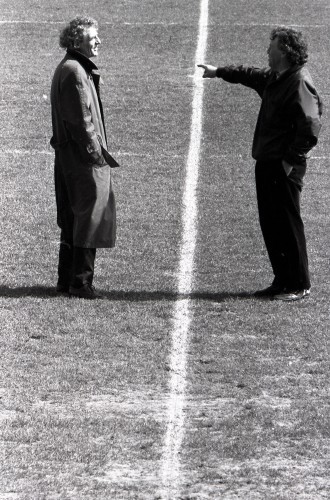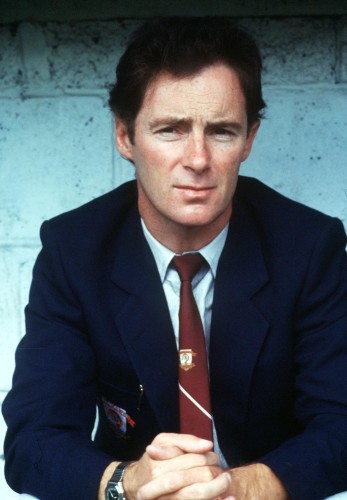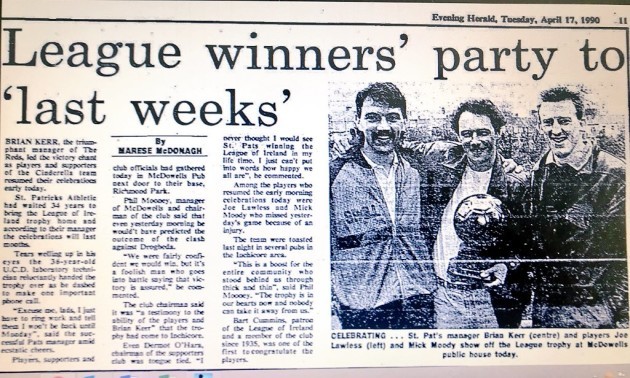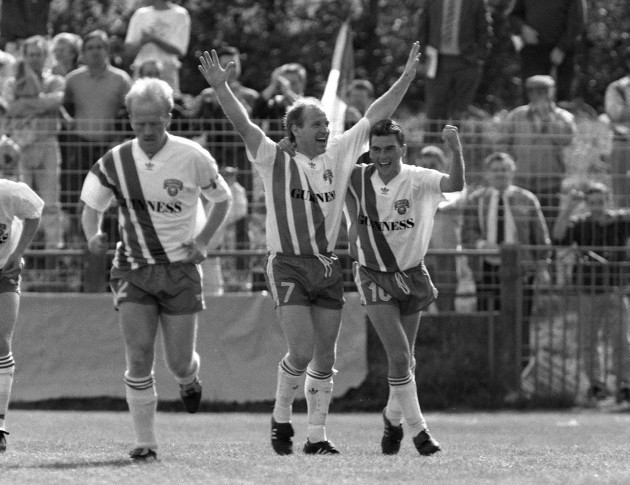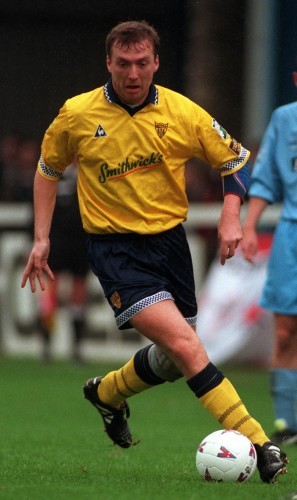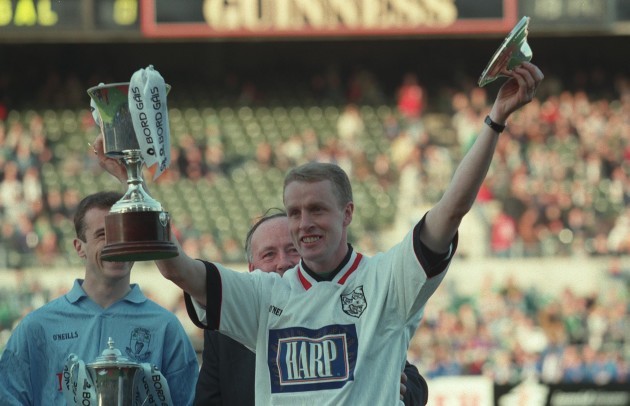“THE HIGHEST FEE I ever paid was the £2,000 we gave to Bohs for Joe Lawless in the summer of 1989,” former St Patrick’s Athletic boss Brian Kerr wrote in the Irish Independent last year.
“But it was the best money we ever spent — because now I had a Toshack-Keegan type strike force, big Joe and Mark Ennis, paired together up front, the scourge of the league.”
Throughout his 12-year League of Ireland career, Lawless regularly occupied that John Toshack role. And he did it with some success too.
He and Ennis struck up an almost telepathic understanding to lead Pat’s to their first league title since 1956 under Kerr, but originally, it had been alongside Ciaran Cooper at Bray Wanderers. The centre forward linked up with Jackie Jameson and Dave Tilson during two spells at Bohemians — winning the FAI Cup in 1992 — while he also provided a foil for the great Liam Coyle as Derry City lifted the League Cup two years later.
Deploying a little and large pairing up front may now be somewhat out of fashion, but it was standard practice in the 1980s and 90s.
“I look at football and see how things are set up nowadays in terms of the players who play in my position,” Lawless begins. “It was always a 4-4-2 when I played. You had your two strikers up front, one centre half looked after the big man and the small fella would drop off.
I played that way so many times throughout my career — as the target man with my strike partner playing off me. It was always a two-man strike force, but you very rarely see that these days.”
Long before he was lining out for some of the country’s top sides, the Ballyfermot native began what would turn out to be a lifelong association with his local team, Cherry Orchard.
It started as a boy in the mini-leagues and Lawless went on to play his entire schoolboy career at the one club. By 17, he was spotted and offered the chance to join Shamrock Rovers, who had gone into a period decline after dominating much of the 50s and 60s. One of Irish football’s greats, John Giles, returned to Ireland in 1977 and agreed to take over the Hoops as player-manager, so a move appealed to the ambitious youngster.
“Originally, they wanted me to go full-time, believe it or not, but I had just started my trade as a butcher,” Lawless explains. “My poor mother, Lord rest her soul, told me to stick with that as she said I’d need it more than the football at the end of the day.
“So I just went part-time, but I was given expenses to make my way over from Ballyfermot to Milltown.”
Prior to going three decades without a home ground to call their own, Rovers were at that point still playing at Glenmalure Park.
“We used to train in the stadium’s car park,” he recalls. “You’d do your running up and down the steps of the terraces, and you had a small weights area in the stands. It was very limited.
“We then trained out in UCD too but in the winter time, it was always back to Milltown because there were lights in the car park. We were on the tarmac, which wasn’t ideal, but it was okay for your ball work because you had been brought up playing on the streets.”
On Giles, Lawless adds: “He would always make sure to come in and say hello to you. If you were brought on to the panel but you didn’t make the squad, he would tell you what you should be doing and that. Eamon Dunphy and Alan Campbell were there too, as was the late Ray Treacy, who I got on really well with.”
Despite looking back fondly at his two years with Rovers, the Dubliner knew it was time to go after falling out of favour with the reserve-team manager.
“I had no big issues with him, but he left me out after I had scored a couple of goals,” he says. “I was always a bit hot-headed, I probably still am, and I just thought ‘I’m not having that and sitting on the bench’.
“So I went back to Cherry Orchard with John Wilkes. He had been over at Rovers as well and was an excellent manager. John just said ‘Stick with the Orchard for a couple of seasons, get your confidence back up again and we’ll see where it goes’.”
As it turned out, Wilkes’ advice was spot on. Lawless helped his boyhood club win three FAI Junior Cups and he had just scored the winner in a quarter-final against Wayside Celtic when Bray Wanderers boss Pat Devlin got in touch.
“That game was the Sunday, and I got a phone call from Pat on the Monday morning,” he remembers. “I went out training with Bray on Tuesday, signed for them on the Thursday and I played against a team from Kilkenny, EMFA, that weekend.
“Pat threw me in straight away. In the first 20 minutes, the pace was a little bit frantic, but I was always quick. I had a few years playing junior football under my belt, in what was a very physical set-up, and that stood me in good stead. I scored and we won 2-1, so that was it.”
Competing in the newly-formed First Division, the Seagulls were crowned the inaugural champions in 1985/86. To celebrate clinching the title, the whole squad was rewarded with a holiday to the States.
“My time at Bray was brilliant, the crowds at the Carlisle Ground were fabulous,” Lawless says. “It was a great community club, Pat was excellent and so were his backroom staff. They brought us to Florida for 18 days after winning the league — all expenses paid. What a trip!”
The following season was hampered by injury, and when he returned to fitness, an invite to join Bohemians arrived via Gypsies manager Billy Young.
It proved an easy decision.
“I thought I was ready to make the next step, with Dalymount Park and everything else that came with the club. So I linked up with an absolutely fabulous Bohs team. They had players that were very hard to play against, and were always tough to beat. When I got the opportunity to play with them, it was unbelievable.
You would get 10,000 people at the games and the pitch was absolutely huge. There was nowhere to hide out there.”
He speaks highly of that side and lists off names such as goalkeeper Dermot O’Neill, Ronnie Murphy, Barry Murphy, Tom Conway, Alan Kinsella, Derek Murray, Derek Swan, Jackie Jameson and Martin Duffy.
Despite a strong first year in Phibsborough, they were pipped to the title by Dundalk in 1987/88. Having qualified for the Uefa Cup, Bohs also took Aberdeen four years after they had lifted the Uefa Cup Winners’ Cup under Alex Ferguson. The first leg in Dublin ended 0-0, and although they narrowly lost out 1-0 in the return tie at Pittodrie, the visiting team were applauded off the pitch.
In 1989, Lawless looked set to return to pre-season when the phone rang. Brian Kerr was on the other end.
“He said ‘Listen, I want to have a chat with you’… the usual,” the striker tells. “I always wanted to better myself, so I said ‘Yeah, no problem’. There was some toing and froing as he said he’d give me this and I said I wanted that, but we came to an agreement, and Brian told me ‘You’re the missing piece of the jigsaw’.”
Previously Mick Lawlor’s assistant at Drogheda United, Kerr took the Pat’s job and began cobbling together a team he felt could end the club’s long wait for league success.
“Of all the teams I played for, that was undoubtedly the best,” declares Lawless. “We had Curtis Fleming, Pat Kelch, Mick Moody, Johnny McDonnell, Damien Byrne, Dave Henderson, Pat Fenlon, Tony O’Connor, Maurice O’Driscoll, Paul Osam and Mark Ennis. Then we had lads off the bench like John Kelly and Colm Seville, to name but a few.
“The first 11 was picking itself, but in fairness to Brian, no matter how well you played he would always change it. He was probably one of the first that would rotate his teams regularly. The way Brian saw it, he didn’t want complacency. You would go out and play brilliantly and then he would name the team the following week and players would be scratching their heads thinking ‘Why amn’t I starting?’. That was his way of managing people and he was brilliant at it. His attention to detail was second to none.”
With Richmond Park under redevelopment, the Saints played their home matches at the greyhound track in Harold’s Cross. The facilities were far from ideal, but it didn’t halt their rise to the top.
“I never played for Pat’s at Richmond Park,” Lawless says. “We were over in Harold’s Cross at the time and it was terrible. We were playing Shelbourne one day and there was a door between the two dressing rooms but it was off the hinges so you could hear the opposition’s team talk.
So the Greener, as Kerr was known, brought us into this office — 18 of us. It was tiny, and we’re all squeezed in there so he could give his team talk. He wouldn’t do it in the dressing room because they would hear, and we went out and won 3-0. We all nearly died of heat stroke in there beforehand, but it was about the little details.
“I gained loads of experience from the way he did things. I always like training and he would make sure to match you together evenly and not put you in with any slouches. He knew that would ensure everyone pushed each other. We trained three nights a week but I would be doing my own bits as well. I did it because I wanted to stay in the team.”
Working as a butcher all through his playing days, Lawless balanced football, his job and a young family, but feels he would have relished the full-time environment.
“You dealt with it [the various commitments],” he says. “When your game was a Sunday, you got a rest but when they brought in Friday night football it meant you had to knock off early and then play after doing a hard week’s work. You’re trying to get yourself up for it and sometimes it might take 20 minutes to get your legs going. That was the way it was then but everybody adapted to it.
“I would have loved to get the opportunity to go full-time and see how I could do. There are some smashing teams in the league now, but I feel like it’s a bit predictable with Cork and Dundalk. The days we played, there were six teams that could win the league. It was much more competitive.
“The conditions are much better for the players now — better surfaces, great facilities, anything you want. The pitches are fabulous now, whereas we played in muck.
“At Pat’s, we used to train on the tar over at Keogh’s Square, and there would have been bottles, smashed glass… you name it, but we would get a sweeping brush and Brian would say ‘Let’s go’. There was a spot called the Pen too, that had sheep and all sorts on it but we would go up and train there. That was madness, but we just got on with it because there was nothing else.”
In April 1990, Kerr’s meticulous plan paid off and, at the age of 36, the UCD lab technician — who would go on to manage his country — led Pat’s to their first title in 34 years.
“Winning the league with Pat’s was great, and being a Ballyfermot lad made it even better,” says Lawless. “I was working in Inchicore at the time, just around the corner from the ground and it was an amazing experience.
I had two great years at Pat’s. I played with some smashing players, but all-round that was one hell of a team — one of the best around.
“One disappointment was that the club knew Shamrock Rovers, Bohs and other clubs were all after the squad. It wasn’t the sun, moon and stars that the players were looking for, it was just another decent contract. Unfortunately, we didn’t get them and that’s why the team went their separate ways.”
As he explains, that side were robbed of the chance to become dominant over several years as many top players were allowed to leave due to financial troubles. By 1991, Lawless agreed to a second spell at Bohs after speaking to then boss Eamonn Gregg. There was a stark contrast between the two clubs, as he was leaving a vastly-experienced outfit to join a relatively youthful one.
“When I signed back, Eamonn said ‘There are a lot of young lads with plenty of potential, but you’re an experienced player and that’s one of the reason I’m getting you in here’. Then he signed Robbie Best and Paul Whelan, Ronnie’s brother, which made us a bit more solid.”
It wouldn’t be long before he landed some more silverware, however, as the Gypsies lifted the FAI Cup in 1992. After seeing off Bluebell United, Dundalk (after a replay) and St James’ Gate, they set up a final date Cork City at Lansdowne Road. The Leesiders, who had held the mighty Bayern Munich to a 1-1 draw the previous year, were favourites on the day and Bohemians’ late arrival didn’t appear to help their cause.
“We were kids going out to play against the likes of Dave Barry, Pat Morley, John Caulfield, Phil Harrington the goalkeeper, and Declan Daly, who was one of the best centre-halves in the league. These lads were all experienced.
“There was such a laid-back atmosphere in our camp that day. I’ll never forget it, we were in the Royal Dublin Hotel and we were having our breakfast. I remember saying to Paul Whelan ‘We’d want to get going’. He said ‘Yeah, Eamonn has it all sorted’. As it turned out, we got delayed and needed a police escort to bring us to the stadium. We arrived at Lansdowne Road 25 minutes before kick-off. So we’re coming in dressed in our suits and they were heading back in off the pitch after their warm-up!
“They were more less saying ‘What do these fuckers think they’re at?’. So we were on our way out to and Declan Daly said ‘Typical Dublin lads’.
“We ended up beating them 1-0 but how we did it that day is beyond me because Cork played really well. That said, we defended with everything. Our goalkeeper John Connolly was only 18 and their tactic was to put everything under him and they would attack the ball, but he dealt with it.”
Dave Tilson proved the hero with a well-taken goal to hand Bohs victory as the trophy made the short trip across the Liffey after a 1-0 win.
The celebrations spilled into the next day, when both teams met up in Dublin to enjoy a pint or two.
“We went to the Mansion House and I got talking to a couple of the Cork lads and they were asking ‘What were you playing at showing up so late?’ but it worked for us as we were all relaxed and didn’t have time to get nervous,” says Lawless.
“It was brilliant, the two teams had drinks together on Baggot Street and afterwards their bus pulled up outside O’Donoghue’s. It’s only a one-way system so they were all piling on.
We’re there waving them off when we realise they have the cup up on the bus with them! None of us had copped it, so eventually we got them to hand it back out the window to us.”
After one more season with Bohs, Lawless then enjoyed a stint north of the border.
“Noel King was taking over Omagh Town and asked if I fancied going up there,” he explains. “I didn’t particularly want to but I gave it a go, playing three matches for them. When I came back, the Derry City boss Tony O’Doherty got in touch, and I went up and signed a deal for two years. He was totally different from what I was used to. He was mad, absolutely bonkers. First of all, I couldn’t understand what he was saying with that thick Derry accent.
“He’s a lovely man but everything was forceful with him and it wasn’t at all what I was used to.”
Spending half the week in Dublin and travelling up with team-mates Dermot O’Neill and Donal O’Brien, they lived out of the Everglade Hotel for the other half. Despite an experiencing an element of sectarian abuse, it was a positive experience overall.
“It was great,” Lawless says. “They were a fabulous club to play for. The supporters were brilliant, but there were two different sections of them. They all supported Derry but they had a difference of opinion with regard to where you were from.
“In the old Brandywell, you had to walk through this cage to get onto the pitch. One side was fine, and while the other lads would have your jersey on them, they were gobbing and spitting at you.”
He also got the opportunity to play alongside one of the League of Ireland’s all-time greats with the Candystripes.
“Liam Coyle was smashing, what a footballer. He could have been everything, only for the knee injury. My God, he was strong, he had pace, his first touch was unbelievable and he knew how to finish. I got on great with him. Peter Hutton was another smashing lad, Paul Curran too. They would have died for the cause and everything was Derry City. You can understand that as well.”
On the best players he played against and toughest opponents, Lawless adds: “I was very fortunate to play with some top players. I look at centre forwards and Mark Ennis was a brilliant goalscorer, Ciaran Cooper at Bray, Dave Tilson with Bohs, but the best centre forward I played with was Liam. If you’re looking for all-round players, you could pick Curtis Fleming, Pat Fenlon, Tony O’Connor… all quality players.
“The hardest opponent I played against was a centre-half from Dundalk. When I was with Cherry Orchard, he played for Mount Tallant. He was a Scottish lad called James Coll, he’s actually a postman up the road now.
This guy was hard as they come, but that was the way you could play then. I was the same, you’d kick lumps out of each other, but after the game you would shake hands and it was be over and done with. Let’s go and have a jar. That’s the way he was, it’s brilliant and I have lots of time for him.”
The Candystripes lifted the League Cup that year, but suffered heartbreak in the FAI Cup final — going down 1-0 to Sligo Rovers.
“I felt the way the Cork lads felt when we beat them because Sligo came up late, Derry were the favourites and we had a luxury coach, whereas they were on a banger of a bus. They did the same as we did to Cork, in that we played really well and they defended excellently. They got a goal and we just couldn’t break them down. That was a hard one to take.”
When Felix Healy took over as Derry manager in 1994, it spelled the end of Lawless’ time with the Foylesiders. They had never seen eye-to-eye, so he didn’t expect to be in the new manager’s plans.
“He said to me ‘You won’t play for this club again’. I said ‘Alright, no problem’. Three weeks later, there was an injury crisis and he rang to say I had to travel with the squad. We went to Athlone, we won 2-1 and I scored the two goals.
“I came off the pitch and went into the dressing room and he says ‘That’s your last game for me’. I said ‘Okay, just fix me up and I’ll be gone’. So they bought me out of my contract and I signed for Waterford.”
At 34, Lawless knew he was coming to the end of his career. After a decent start, things turned pear-shaped at the First Division club and manager Mick Bennett departed. His achievements at the top level meant it was difficult to adjust and he decided to meet with the board and bow out of League of Ireland football.
“I was used to playing at a very high level with very good players,” Joe admits. “When you drop down, the standard of player drops. The game is totally different — it’s slower, it can lack intensity and I didn’t want to just be hanging on for the sake of it.”
That said, he agreed to play with Leinster Senior League side Moyle Park under friend Paul O’Brien. His old manager John Wilkes then came calling to bring him back to the Orchard in a coaching capacity.
It was shortly-lived, however, due to a nasty injury suffered on the very first night of training.
“We had just done a long run, and everyone was knackered,” he tells. “John asked me to get the ball out and let the lads get their legs working. So I set up a little pitch. He said I could step in if I wanted to, so I did, when this young fella came from behind and smashed my ankle in five places. The very first night. I’ve a plate in my bleedin’ leg over it.
“In fairness to Cherry Orchard, I hadn’t signed anything as I had just said I would go down to give it a go. I was in the middle of moving from Kingswood Heights in Tallaght to Blessington with the wife and kids at the time, but it was that bad that I spent three weeks in hospital. I was just glad it happened at the end of my career and not at the start of it.
But they paid my wages for the whole time I was out. I would always have been thought of as one of their own.”
It’s a testament to the kind of club they are, and next month Lawless will join 40-ex Cherry Orchard players on a trip to Portugal to remember club legend Jem Byrne, who passed away last September.
“I’m looking forward to it, it’s his anniversary so that will be nice,” he says. “If it was 30 years ago, I’d say ‘Ah no, this is a car crash’, but because everybody is in their 50s now you’re that bit older. There’ll be a few pints and we’ll probably fall asleep! You have to pace yourself these days.
“Jem was the man who used to come up to me and give me my wages after the injury. He was a friend of mine, and he had said ‘Don’t worry Lawl’, I’ll get you sorted. You can’t have that, with you moving and all’.
Lawless, now 56, still managed to enjoy a couple of years as player-manager of Blessington Football Club — leading the AUL side to their first two cup wins in 40 years lining out at centre-half. “It was probably the best celebrations I have had for any trophies, because they went on for about two weeks,” he smiles.
It’s easy to lose contact with old team-mates over time, but the Bohs team of 1992 were brought together to attend the 2017 FAI Cup final at the Aviva Stadium and celebrate the 25th anniversary of their cup triumph.
“You’ll always have friends if you played League of Ireland, but you may not see them for a long time and then something like this comes up, and lads set up a WhatsApp group,” Lawless adds.
“You meet them after 25 years and you’re looking at lads and saying ‘Jaysus Christ, I haven’t seen him in ages’, then the slagging starts about fellas losing their hair and putting on weight or whatever.
“It was brilliant, and we had a ball for the two weeks. We were invited over to Dalymount for a free night, then we went to the FAI Cup final and we got momentos from the president.
“We all met up for a game of golf three or four weeks ago. They’re trying to organise that we’ll meet once a year and keep in touch, because you lose track. Everyone has busy lives so it’s great to do.”

